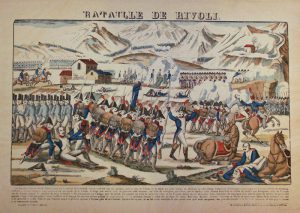Anthony Burgess and Napoleon Bonaparte
2015 is the two hundredth anniversary of the Battle of Waterloo, and to mark the occasion we present a new exhibition looking at some of the material relating to Napoleon Bonaparte held in the Burgess Archive. The exhibition contains prints from Burgses’s art collection, rare books from the library, manuscripts of Burgess’s Napoleon projects and more.
Burgess was fascinated with Napoleon from a very early age. According to his autobiography, at his birth it was clear that Burgess ‘had to be a great artist of some kind or another … My father breathed beer on me and said ‘He may be a new Napoleon’.’ Burgess did not become a great military leader and had an undistinguished army career, and did not become a writer until much later in life. However, Napoleon emerged as an inspiration in 1971 when Burgess wrote the beginnings of a novel based on Napoleon’s life that Stanley Kubrick hoped to use as the basis for a film. The novel took the formal structure of Beethoven’s Third Symphony (the Eroica, originally dedicated to Napoleon before his invasion of Switzerland), with each section of the narrative corresponding to a passage in the score.
In the event Burgess’s text was not used, as Kubrick felt Burgess’s freedom with the chronology of events confused the drama of the story, and that Burgess’s comic vision of Napoleon fell short of his heroic stature. But Burgess went on to develop his text into one of his most important and experimental works, Napoleon Symphony.
Napoleon Symphony appeared in five languages on publication and was warmly received by critics. It closes with ‘An Epistle To The Reader’, a 181-line poem in rhyming couplets articulating the way in which musical forms are used in the text and explaining its modernist ambitions – a virtuoso conclusion that demanded a virtuoso response from Burgess’s translators, who also had to contend with the significant challenges of many changes of register from high politics to low slang, a great deal of idiomatic dialogue, and army and drinking songs peppering the text.
Here is a sample review: ‘In an age of dull prose, jargon of sociology and psychology, incessant buzz of gossip, the endless dribble of weepy-eyed ghetto hysterics, tin clatter of avant-garde mobiles, hollow academic puling: a reader who delights in succulent phrase, the zest of word play and a saucy paragraph must fall on each new work of Anthony Burgess with ravenous appetite … Burgess at his most characteristic, craziest, surpasses the high fun of the invented language in A Clockwork Orange‘ (Mark Mirsky, Washington Post Book World, 26 May 1974).
The exhibition is free and is open weekdays 10am-2pm, and during the evenings when events are taking place in the Engine House building. Napoleon Symphony is published by Serpent’s Tail in the UK and W.W. Norton in the USA, and is available from all good bookshops.





